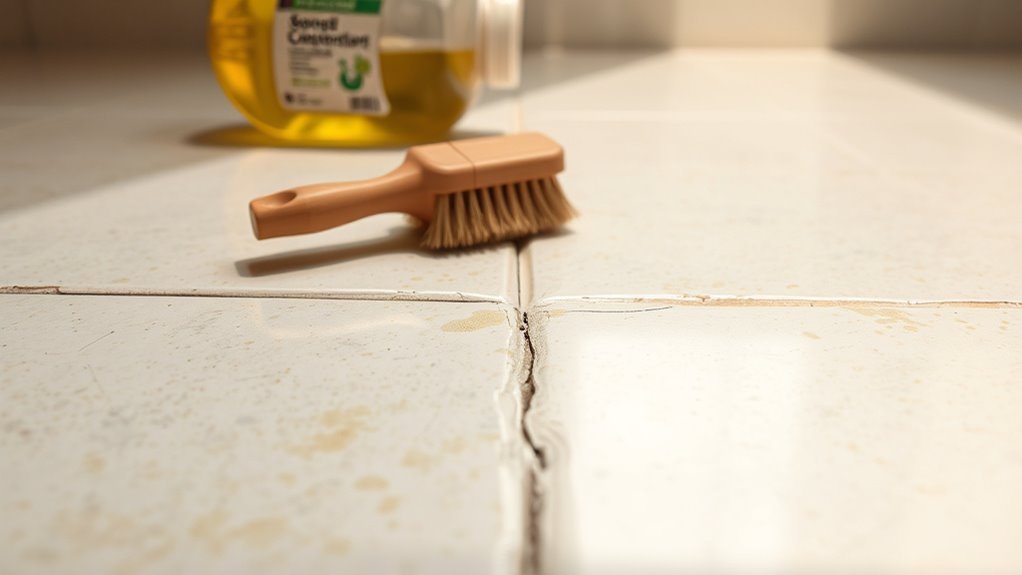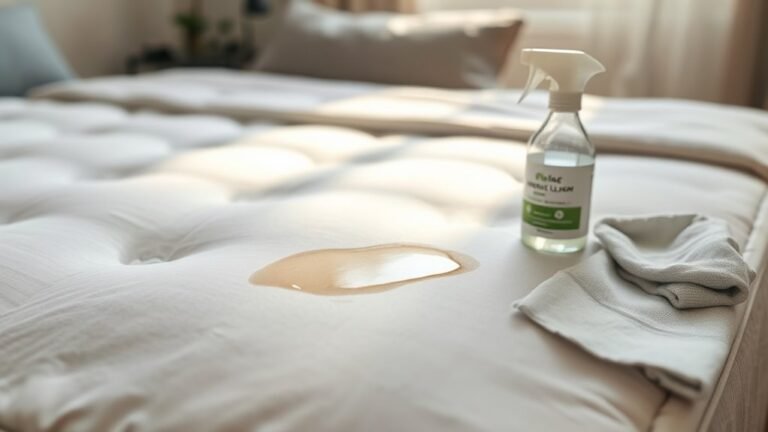Cleaning Mistakes That Damage Your Grout
You’re damaging your grout if you use harsh chemical or colored cleaners that stain, scrub too aggressively, or apply too much water, which erodes the grout and weakens tile bonds. Skipping regular sealing leaves grout porous and vulnerable to dirt and moisture. Neglecting routine cleaning allows grime build-up and mold growth, further degrading grout. Using improper tools like wire brushes accelerates wear. Knowing how to avoid these mistakes helps keep your grout strong and looking great.
Using Harsh Chemical Cleaners
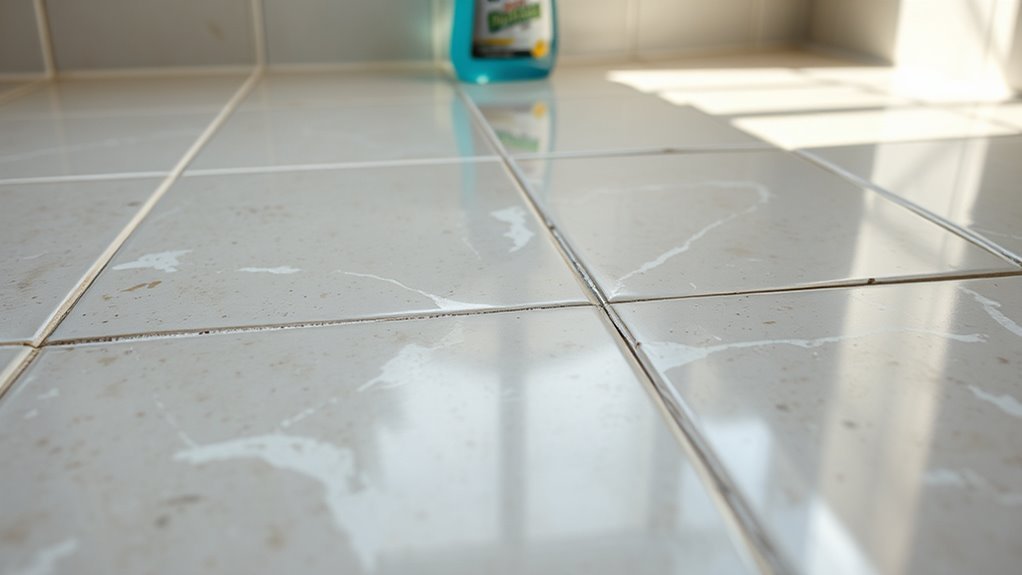
Although harsh chemical cleaners might promise quick results, they can actually erode your grout over time, causing it to weaken and discolor. When you rely on strong chemicals, you risk leaving behind chemical residue that continues to damage the grout long after cleaning. This residue can attract dirt and cause staining, negating your efforts. It’s essential to evaluate cleaner compatibility with your grout type before applying any product. Not all cleaners are safe for all grout materials, and using the wrong one can accelerate deterioration. To protect your grout and maintain its integrity, choose gentle, pH-neutral cleaners designed specifically for grout. By doing so, you preserve its strength and appearance while avoiding the pitfalls of harsh chemical damage. Using eco-friendly cleaning products can also provide effective cleaning while protecting both your grout and the environment.
Scrubbing Too Aggressively
Scrubbing too aggressively can do more harm than good when cleaning grout. When you apply excessive force, you risk eroding the grout’s surface, leaving it porous and vulnerable to stains and damage. Instead, focus on gentle scrubbing techniques that work with the grout, not against it. Choose the right cleaning tools—soft-bristle brushes or microfiber cloths—that effectively remove dirt without abrasion. Avoid wire brushes or harsh scrubbing pads, which might seem efficient but can weaken grout lines over time. By adopting controlled, consistent movements, you preserve the grout’s integrity while achieving a thorough clean. Remember, freedom in maintenance means protecting your surfaces without unnecessary wear. Use smarter scrubbing techniques and appropriate cleaning tools to keep your grout intact and looking fresh. Additionally, neglecting sealant maintenance exposes grout to stains and moisture, making gentle cleaning even more crucial.
Ignoring Regular Sealing
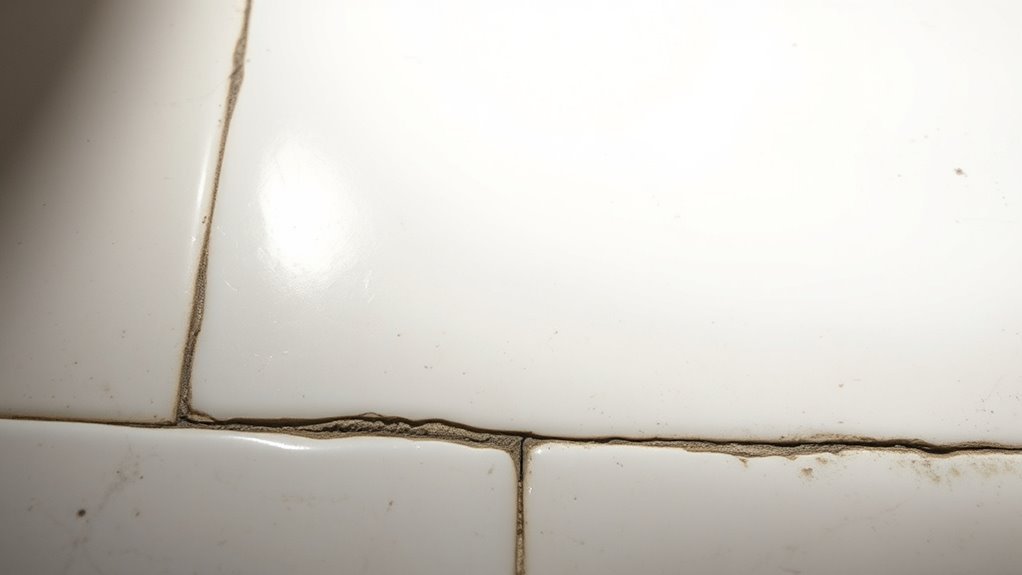
If you skip sealing your grout regularly, dirt and moisture can seep in, causing stains and damage. Sealing creates a protective barrier that keeps grout cleaner and extends its lifespan. You should reseal grout every six to twelve months to maintain its defense. Choosing the right grout sealant based on your grout type and location is essential for optimal protection.
Importance of Grout Sealing
When you skip regular grout sealing, your grout becomes vulnerable to stains, moisture, and mold. Sealing acts as a protective barrier, preserving grout’s integrity and appearance. To maintain freedom from frequent repairs, follow grout maintenance tips that emphasize sealing frequency—typically every 6 to 12 months, depending on the area’s usage and exposure to water or dirt. Proper sealing prevents dirt buildup and reduces cleaning effort, saving you time and hassle. Neglecting this step compromises grout durability, leading to costly restoration. Make sealing a routine part of your cleaning regimen to keep grout strong and looking fresh. By committing to timely sealing, you protect your investment and enjoy a cleaner, healthier space without unnecessary restrictions or damage.
Effects of Skipping Sealing
Although grout sealing might seem like a minor task, skipping it can lead to significant damage over time. When you ignore regular sealing, grout becomes vulnerable to dirt, stains, and moisture infiltration. This accelerates wear, discoloration, and even mold growth, limiting your freedom to maintain a clean, fresh space. Different sealing methods offer varying levels of protection, but regardless of which you choose, neglecting them undermines grout’s durability. Sticking to a proper sealing frequency guarantees your grout resists damage and stays easier to clean. By overlooking sealing, you risk costly repairs and a compromised appearance. To preserve your grout’s integrity and avoid these issues, make sealing a consistent part of your cleaning routine rather than an afterthought.
How Often to Seal
One to two times a year is generally recommended for sealing grout to maintain its protection and appearance. Sticking to this sealing frequency guarantees your grout stays resistant to stains, moisture, and dirt buildup. When you ignore regular sealing, grout can absorb grime and moisture, leading to discoloration and damage that’s harder to fix. The sealing benefits aren’t just cosmetic—they also extend your grout’s lifespan and make cleaning easier. You don’t have to worry about constant upkeep, but skipping sealing altogether compromises your tile’s durability and your freedom to enjoy a clean, fresh space. By committing to the right sealing frequency, you protect your investment without hassle, keeping grout strong and looking great for years to come.
Neglecting Routine Cleaning
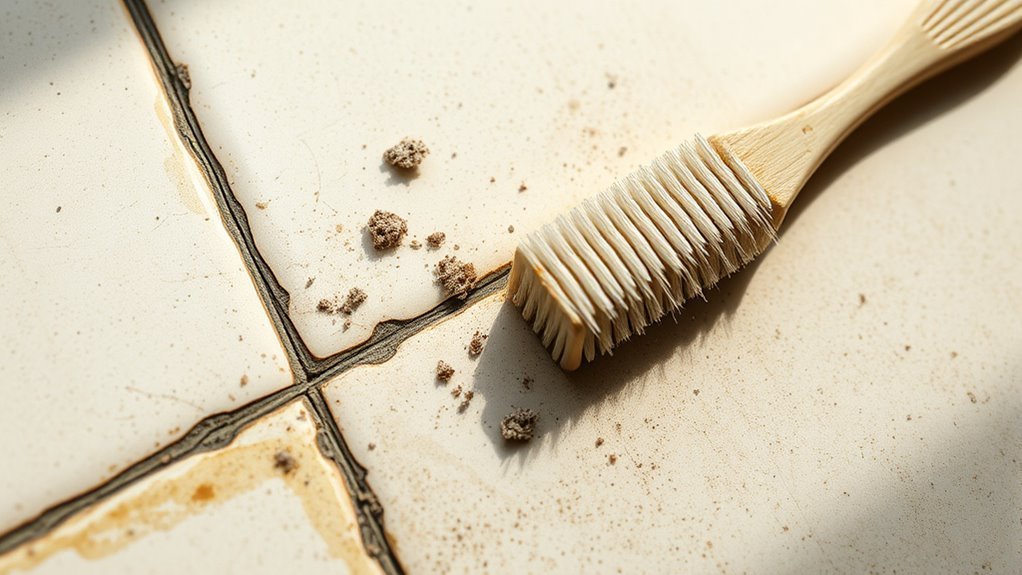
Failing to clean grout regularly allows dirt and grime to build up, making stains harder to remove and leading to permanent discoloration. If you neglect routine cleaning, you’ll find that grime settles deep into the porous surface, weakening grout integrity over time. To protect your floors and walls, establish a consistent cleaning schedule tailored to your space’s traffic and usage. This routine maintenance prevents dirt accumulation, preserving grout’s appearance and durability. Skipping this step might seem like a time-saver, but it often results in costly repairs or replacements down the line. By committing to regular cleaning, you maintain freedom from stubborn stains and damage, keeping your grout fresh and resilient without unnecessary hassle. Don’t let neglect compromise your grout’s longevity—stick to your cleaning schedule. Understanding that grout is porous helps explain why regular cleaning is essential to prevent dirt and moisture absorption.
Using Colored Cleaners That Stain
Several colored cleaners contain dyes that can permanently stain grout if you’re not careful. When choosing a cleaner, pay close attention to color selection—opt for colorless or specifically grout-safe products to avoid unwanted discoloration. Not all cleaners are compatible with every grout type, so checking cleaner compatibility is vital before use. Using a colored cleaner without verifying this can lead to stubborn stains that are tough to remove, limiting your freedom to keep your grout looking fresh. Always test a small, inconspicuous area first to guarantee the cleaner won’t alter your grout’s appearance. By prioritizing compatibility and thoughtful color selection, you protect your grout from damage and maintain the clean, crisp look you want without surprises. Additionally, it’s important to test cleaning methods on a small area first to ensure safety and effectiveness.
Applying Excessive Water
You might think using lots of water is helpful, but soaking grout can weaken it over time. Excess moisture creates the perfect environment for mold and mildew to thrive. Plus, constant exposure to water can erode grout, leading to costly repairs.
Water Soaking Effects
Although water is essential for cleaning grout, applying too much can cause serious damage. When grout absorbs excessive water, it leads to prolonged moisture retention within its porous structure. This constant saturation weakens the grout’s integrity, making it susceptible to crumbling and erosion over time. You might think soaking the area guarantees cleanliness, but water absorption beyond what grout can handle compromises its durability. Excess moisture also disrupts the bond between grout and tiles, potentially causing tiles to loosen or crack. To protect your grout’s longevity, use water sparingly and avoid saturating surfaces during cleaning. Controlling water application lets you maintain a clean space without sacrificing the strength and appearance of your grout.
Mold and Mildew Growth
When grout stays wet for too long, it creates the perfect environment for mold and mildew to thrive. Applying excessive water during cleaning can lead to persistent dampness that encourages mold growth, damaging your grout and compromising your freedom to enjoy a clean space. To protect your grout and guarantee effective mold prevention, follow these steps:
- Use just enough water to clean without soaking the grout.
- Dry grout thoroughly after cleaning to eliminate moisture.
- Apply mildew treatment products as needed to stop early growth.
Grout Erosion Risks
If grout is exposed to excessive water repeatedly, it starts to erode and weaken over time. This erosion shortens your grout lifespan, leaving tiles vulnerable and less secure. When you soak grout unnecessarily during cleaning, water seeps into tiny pores and washes away binding agents. Over time, this causes cracks and gaps that are hard to repair. To protect your grout and extend its lifespan, limit water use during cleaning. Opt for damp mops or microfiber cloths instead of flooding the surface. Also, apply protective measures like sealing grout regularly to repel moisture. By controlling water exposure and following these protective steps, you maintain grout integrity, prevent damage, and keep your tiled surfaces looking fresh and strong without sacrificing your freedom to clean effectively.
Overlooking Mold and Mildew Growth
Why does mold and mildew growth often go unnoticed in grout? It’s because these fungi thrive in damp, hidden spaces and can blend with grout’s texture. If you overlook them, mold and mildew can cause serious damage. To protect your grout, focus on:
- Regular mold prevention by ensuring grout is dry and well-ventilated.
- Prompt mildew treatment using appropriate cleaners designed specifically for grout.
- Routine inspection, especially in bathrooms and kitchens where moisture lingers.
Ignoring these steps can lead to discoloration and weakening of grout, reducing freedom in your cleaning routine. Stay vigilant, apply targeted treatments, and keep your grout strong and clean without harsh over-scrubbing or neglect. This approach guarantees lasting protection and a fresh, healthy environment. It is also important to follow essential safety precautions when cleaning mold to avoid harmful exposure.
Using Improper Tools for Cleaning
Using just one wrong tool can cause more harm than good to your grout. When you reach for improper tools—like harsh wire brushes or abrasive scrubbers—you risk scratching or eroding the grout surface. These damages not only ruin its appearance but also make it vulnerable to stains and moisture. To protect your grout, stick to soft-bristled brushes or microfiber cloths specifically designed for delicate surfaces. Your cleaning techniques matter just as much as the cleaners you use. Avoid excessive force or aggressive scrubbing that can degrade grout integrity over time. By choosing the right tools and gentle methods, you maintain your grout’s strength and appearance, giving yourself the freedom to clean effectively without worry. Don’t let improper tools sabotage your efforts. Additionally, using soft cleaning tools helps prevent surface damage and maintains the grout’s durability over time.
Frequently Asked Questions
How Can I Restore Grout Color After It Fades?
Did you know 85% of homeowners report improved tile appearance after grout restoration? If your grout color has faded, you can restore it by cleaning thoroughly, then applying a grout colorant or stain designed for durability. This refreshes the look without replacing tiles. Seal the grout afterward to maintain vibrancy and prevent future fading. With the right approach, you’ll regain that fresh, clean tile look and enjoy your space freely.
What Natural Remedies Help Brighten Grout Effectively?
You can brighten grout naturally using baking soda mixed with a vinegar solution to create a fizzing cleaner that lifts stains effectively. For tougher spots, apply hydrogen peroxide directly—it’s a gentle bleach alternative. Lemon juice also works well, thanks to its natural acidity and fresh scent. Just make a paste or spray, let it sit briefly, scrub lightly, then rinse. These remedies give you freedom from harsh chemicals while restoring grout’s brightness.
Can Pets Affect Grout Cleanliness or Damage?
Funny enough, your pet’s playful spills and accidents can really test your grout’s durability. Pet stains often seep into grout, causing discoloration and odor. If you don’t use the right cleaning techniques, those stains might set permanently. You’ll want to act fast with pet-safe cleaners and avoid harsh chemicals that can erode grout. Keeping up with gentle, consistent cleaning helps maintain both your freedom and your floor’s fresh look.
How Often Should Grout Be Professionally Cleaned?
You should consider professional cleaning frequency for grout about once every 12 to 18 months to keep it looking fresh and prevent buildup. Following grout maintenance tips like regular sealing and gentle daily cleaning can extend this period. If your floors see heavy traffic or pets, you might need professional help more often. Keeping up with these steps means you won’t be stuck with stubborn stains or damage, and you’ll enjoy cleaner grout with less hassle.
What Are Signs That Grout Needs Replacement?
You’ll know grout needs replacement when you spot common grout issues like persistent cracking, crumbling, or discoloration that won’t improve with cleaning. During grout inspection, look for gaps or missing sections, which allow moisture and mold to develop. If water seeps through or tiles feel loose, it’s time to act. Regular grout inspection tips include checking grout lines closely and addressing damage early to keep your space fresh and protected.
